Zhicheng Wang
Learning Turbulent Flows with Generative Models: Super-resolution, Forecasting, and Sparse Flow Reconstruction
Sep 10, 2025Abstract:Neural operators are promising surrogates for dynamical systems but when trained with standard L2 losses they tend to oversmooth fine-scale turbulent structures. Here, we show that combining operator learning with generative modeling overcomes this limitation. We consider three practical turbulent-flow challenges where conventional neural operators fail: spatio-temporal super-resolution, forecasting, and sparse flow reconstruction. For Schlieren jet super-resolution, an adversarially trained neural operator (adv-NO) reduces the energy-spectrum error by 15x while preserving sharp gradients at neural operator-like inference cost. For 3D homogeneous isotropic turbulence, adv-NO trained on only 160 timesteps from a single trajectory forecasts accurately for five eddy-turnover times and offers 114x wall-clock speed-up at inference than the baseline diffusion-based forecasters, enabling near-real-time rollouts. For reconstructing cylinder wake flows from highly sparse Particle Tracking Velocimetry-like inputs, a conditional generative model infers full 3D velocity and pressure fields with correct phase alignment and statistics. These advances enable accurate reconstruction and forecasting at low compute cost, bringing near-real-time analysis and control within reach in experimental and computational fluid mechanics. See our project page: https://vivekoommen.github.io/Gen4Turb/
Exploring Contextual Attribute Density in Referring Expression Counting
Mar 16, 2025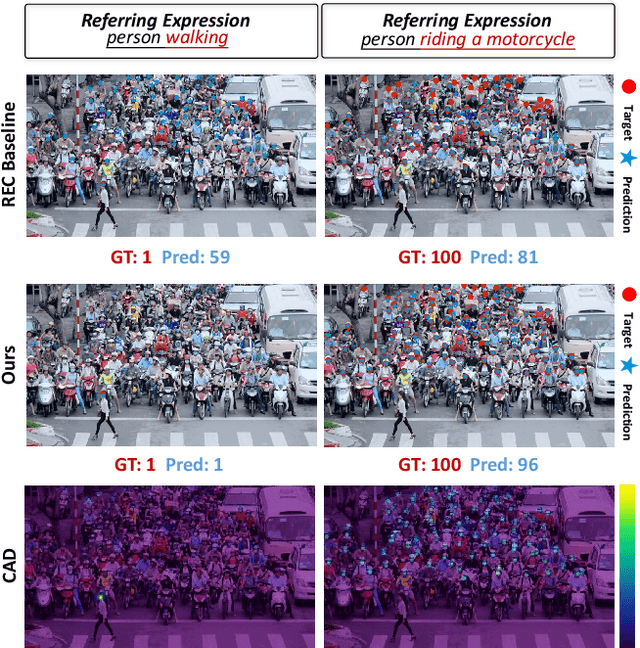
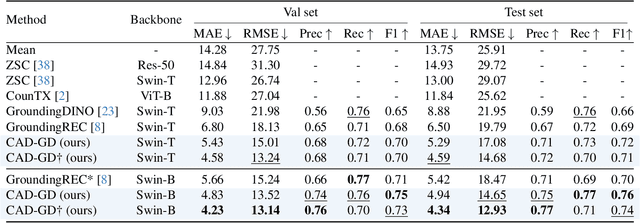
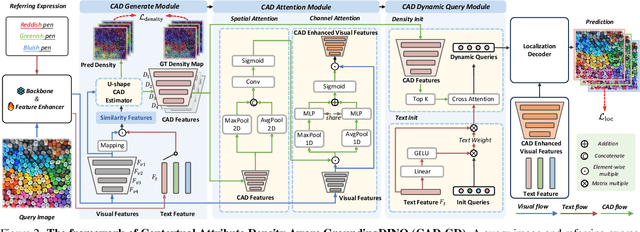
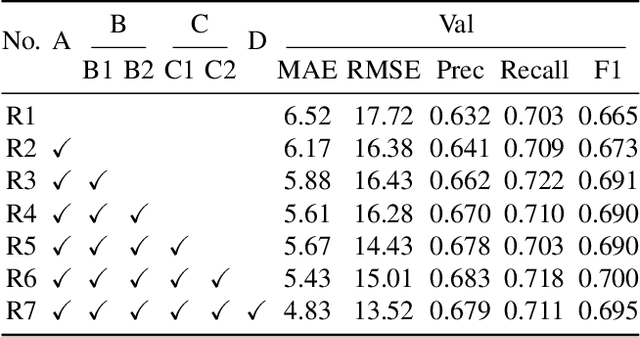
Abstract:Referring expression counting (REC) algorithms are for more flexible and interactive counting ability across varied fine-grained text expressions. However, the requirement for fine-grained attribute understanding poses challenges for prior arts, as they struggle to accurately align attribute information with correct visual patterns. Given the proven importance of ''visual density'', it is presumed that the limitations of current REC approaches stem from an under-exploration of ''contextual attribute density'' (CAD). In the scope of REC, we define CAD as the measure of the information intensity of one certain fine-grained attribute in visual regions. To model the CAD, we propose a U-shape CAD estimator in which referring expression and multi-scale visual features from GroundingDINO can interact with each other. With additional density supervision, we can effectively encode CAD, which is subsequently decoded via a novel attention procedure with CAD-refined queries. Integrating all these contributions, our framework significantly outperforms state-of-the-art REC methods, achieves $30\%$ error reduction in counting metrics and a $10\%$ improvement in localization accuracy. The surprising results shed light on the significance of contextual attribute density for REC. Code will be at github.com/Xu3XiWang/CAD-GD.
Learning and discovering multiple solutions using physics-informed neural networks with random initialization and deep ensemble
Mar 08, 2025Abstract:We explore the capability of physics-informed neural networks (PINNs) to discover multiple solutions. Many real-world phenomena governed by nonlinear differential equations (DEs), such as fluid flow, exhibit multiple solutions under the same conditions, yet capturing this solution multiplicity remains a significant challenge. A key difficulty is giving appropriate initial conditions or initial guesses, to which the widely used time-marching schemes and Newton's iteration method are very sensitive in finding solutions for complex computational problems. While machine learning models, particularly PINNs, have shown promise in solving DEs, their ability to capture multiple solutions remains underexplored. In this work, we propose a simple and practical approach using PINNs to learn and discover multiple solutions. We first reveal that PINNs, when combined with random initialization and deep ensemble method -- originally developed for uncertainty quantification -- can effectively uncover multiple solutions to nonlinear ordinary and partial differential equations (ODEs/PDEs). Our approach highlights the critical role of initialization in shaping solution diversity, addressing an often-overlooked aspect of machine learning for scientific computing. Furthermore, we propose utilizing PINN-generated solutions as initial conditions or initial guesses for conventional numerical solvers to enhance accuracy and efficiency in capturing multiple solutions. Extensive numerical experiments, including the Allen-Cahn equation and cavity flow, where our approach successfully identifies both stable and unstable solutions, validate the effectiveness of our method. These findings establish a general and efficient framework for addressing solution multiplicity in nonlinear differential equations.
PUGS: Zero-shot Physical Understanding with Gaussian Splatting
Feb 17, 2025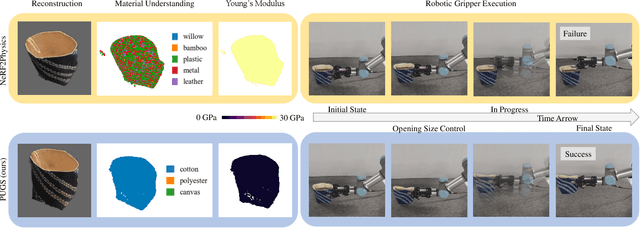
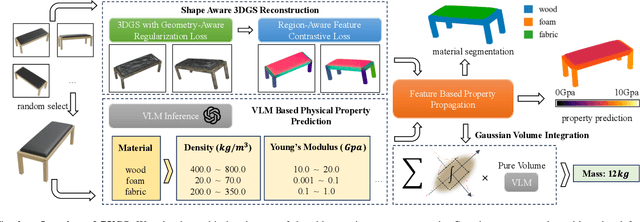
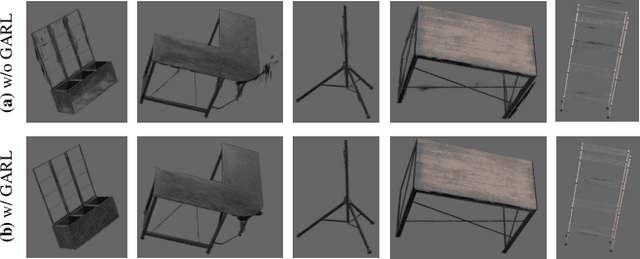

Abstract:Current robotic systems can understand the categories and poses of objects well. But understanding physical properties like mass, friction, and hardness, in the wild, remains challenging. We propose a new method that reconstructs 3D objects using the Gaussian splatting representation and predicts various physical properties in a zero-shot manner. We propose two techniques during the reconstruction phase: a geometry-aware regularization loss function to improve the shape quality and a region-aware feature contrastive loss function to promote region affinity. Two other new techniques are designed during inference: a feature-based property propagation module and a volume integration module tailored for the Gaussian representation. Our framework is named as zero-shot physical understanding with Gaussian splatting, or PUGS. PUGS achieves new state-of-the-art results on the standard benchmark of ABO-500 mass prediction. We provide extensive quantitative ablations and qualitative visualization to demonstrate the mechanism of our designs. We show the proposed methodology can help address challenging real-world grasping tasks. Our codes, data, and models are available at https://github.com/EverNorif/PUGS
Subconscious Robotic Imitation Learning
Dec 29, 2024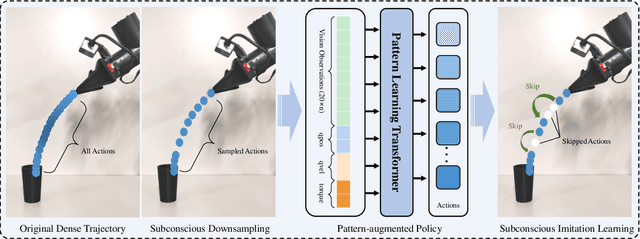
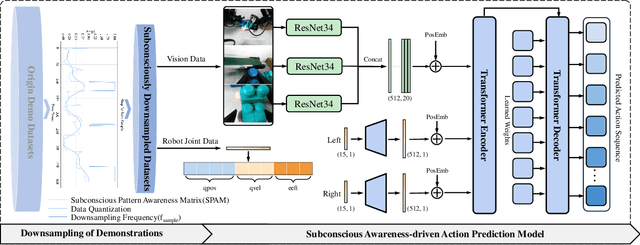
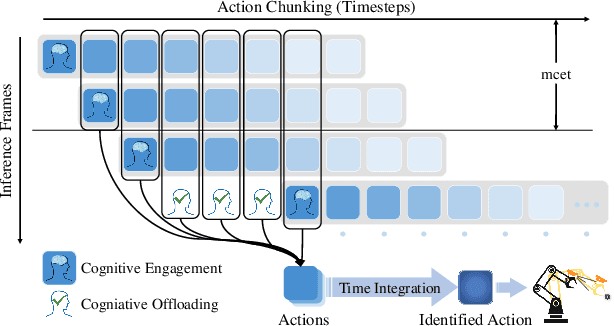

Abstract:Although robotic imitation learning (RIL) is promising for embodied intelligent robots, existing RIL approaches rely on computationally intensive multi-model trajectory predictions, resulting in slow execution and limited real-time responsiveness. Instead, human beings subconscious can constantly process and store vast amounts of information from their experiences, perceptions, and learning, allowing them to fulfill complex actions such as riding a bike, without consciously thinking about each. Inspired by this phenomenon in action neurology, we introduced subconscious robotic imitation learning (SRIL), wherein cognitive offloading was combined with historical action chunkings to reduce delays caused by model inferences, thereby accelerating task execution. This process was further enhanced by subconscious downsampling and pattern augmented learning policy wherein intent-rich information was addressed with quantized sampling techniques to improve manipulation efficiency. Experimental results demonstrated that execution speeds of the SRIL were 100\% to 200\% faster over SOTA policies for comprehensive dual-arm tasks, with consistently higher success rates.
FocusChat: Text-guided Long Video Understanding via Spatiotemporal Information Filtering
Dec 17, 2024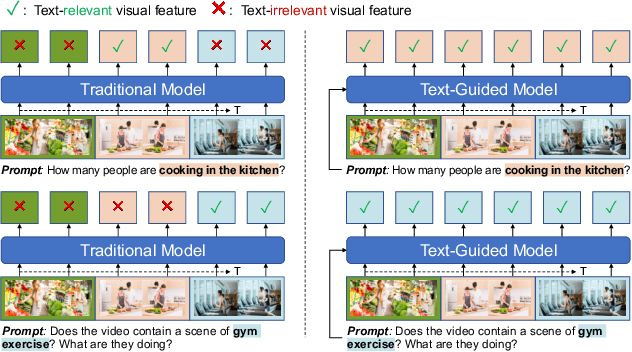

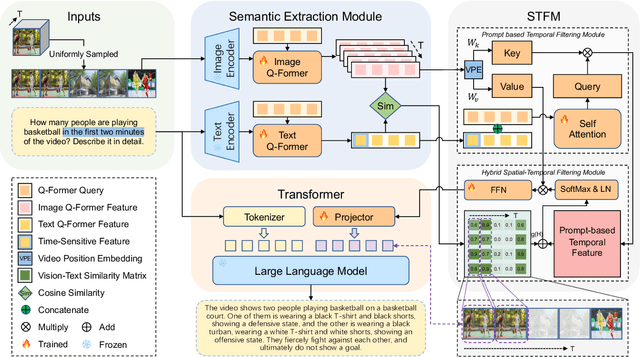
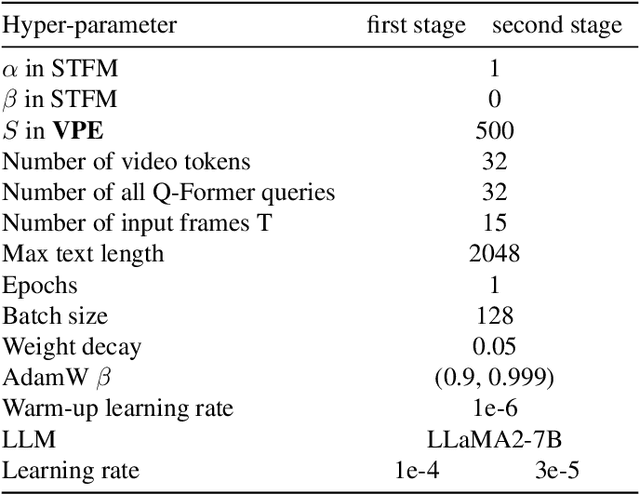
Abstract:Recently, multi-modal large language models have made significant progress. However, visual information lacking of guidance from the user's intention may lead to redundant computation and involve unnecessary visual noise, especially in long, untrimmed videos. To address this issue, we propose FocusChat, a text-guided multi-modal large language model (LLM) that emphasizes visual information correlated to the user's prompt. In detail, Our model first undergoes the semantic extraction module, which comprises a visual semantic branch and a text semantic branch to extract image and text semantics, respectively. The two branches are combined using the Spatial-Temporal Filtering Module (STFM). STFM enables explicit spatial-level information filtering and implicit temporal-level feature filtering, ensuring that the visual tokens are closely aligned with the user's query. It lowers the essential number of visual tokens inputted into the LLM. FocusChat significantly outperforms Video-LLaMA in zero-shot experiments, using an order of magnitude less training data with only 16 visual tokens occupied. It achieves results comparable to the state-of-the-art in few-shot experiments, with only 0.72M pre-training data.
Towards Degradation-Robust Reconstruction in Generalizable NeRF
Nov 18, 2024Abstract:Generalizable Neural Radiance Field (GNeRF) across scenes has been proven to be an effective way to avoid per-scene optimization by representing a scene with deep image features of source images. However, despite its potential for real-world applications, there has been limited research on the robustness of GNeRFs to different types of degradation present in the source images. The lack of such research is primarily attributed to the absence of a large-scale dataset fit for training a degradation-robust generalizable NeRF model. To address this gap and facilitate investigations into the degradation robustness of 3D reconstruction tasks, we construct the Objaverse Blur Dataset, comprising 50,000 images from over 1000 settings featuring multiple levels of blur degradation. In addition, we design a simple and model-agnostic module for enhancing the degradation robustness of GNeRFs. Specifically, by extracting 3D-aware features through a lightweight depth estimator and denoiser, the proposed module shows improvement on different popular methods in GNeRFs in terms of both quantitative and visual quality over varying degradation types and levels. Our dataset and code will be made publicly available.
Takin: A Cohort of Superior Quality Zero-shot Speech Generation Models
Sep 18, 2024



Abstract:With the advent of the big data and large language model era, zero-shot personalized rapid customization has emerged as a significant trend. In this report, we introduce Takin AudioLLM, a series of techniques and models, mainly including Takin TTS, Takin VC, and Takin Morphing, specifically designed for audiobook production. These models are capable of zero-shot speech production, generating high-quality speech that is nearly indistinguishable from real human speech and facilitating individuals to customize the speech content according to their own needs. Specifically, we first introduce Takin TTS, a neural codec language model that builds upon an enhanced neural speech codec and a multi-task training framework, capable of generating high-fidelity natural speech in a zero-shot way. For Takin VC, we advocate an effective content and timbre joint modeling approach to improve the speaker similarity, while advocating for a conditional flow matching based decoder to further enhance its naturalness and expressiveness. Last, we propose the Takin Morphing system with highly decoupled and advanced timbre and prosody modeling approaches, which enables individuals to customize speech production with their preferred timbre and prosody in a precise and controllable manner. Extensive experiments validate the effectiveness and robustness of our Takin AudioLLM series models. For detailed demos, please refer to https://takinaudiollm.github.io.
ConDense: Consistent 2D/3D Pre-training for Dense and Sparse Features from Multi-View Images
Aug 30, 2024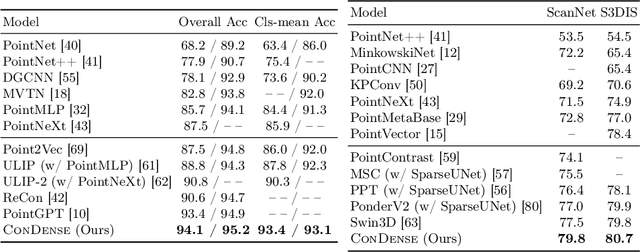
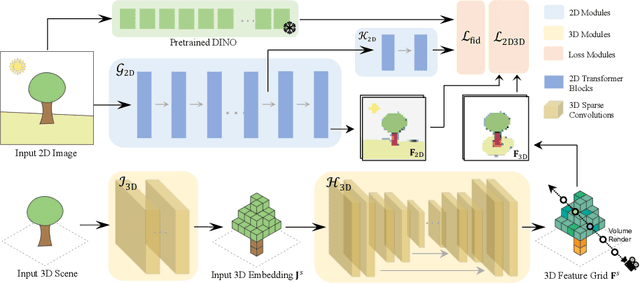
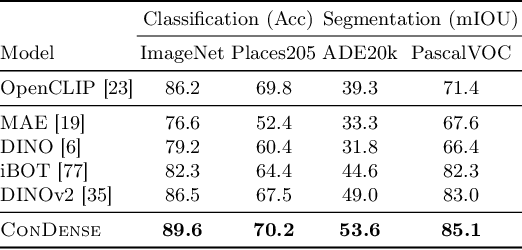
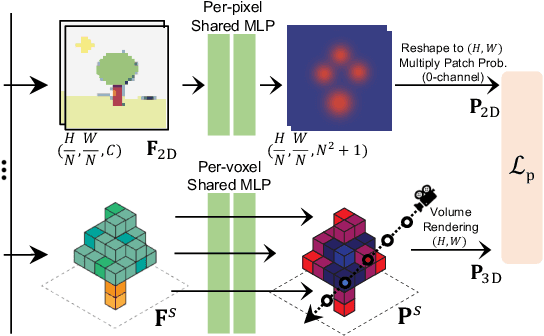
Abstract:To advance the state of the art in the creation of 3D foundation models, this paper introduces the ConDense framework for 3D pre-training utilizing existing pre-trained 2D networks and large-scale multi-view datasets. We propose a novel 2D-3D joint training scheme to extract co-embedded 2D and 3D features in an end-to-end pipeline, where 2D-3D feature consistency is enforced through a volume rendering NeRF-like ray marching process. Using dense per pixel features we are able to 1) directly distill the learned priors from 2D models to 3D models and create useful 3D backbones, 2) extract more consistent and less noisy 2D features, 3) formulate a consistent embedding space where 2D, 3D, and other modalities of data (e.g., natural language prompts) can be jointly queried. Furthermore, besides dense features, ConDense can be trained to extract sparse features (e.g., key points), also with 2D-3D consistency -- condensing 3D NeRF representations into compact sets of decorated key points. We demonstrate that our pre-trained model provides good initialization for various 3D tasks including 3D classification and segmentation, outperforming other 3D pre-training methods by a significant margin. It also enables, by exploiting our sparse features, additional useful downstream tasks, such as matching 2D images to 3D scenes, detecting duplicate 3D scenes, and querying a repository of 3D scenes through natural language -- all quite efficiently and without any per-scene fine-tuning.
PIE: Parkour with Implicit-Explicit Learning Framework for Legged Robots
Aug 27, 2024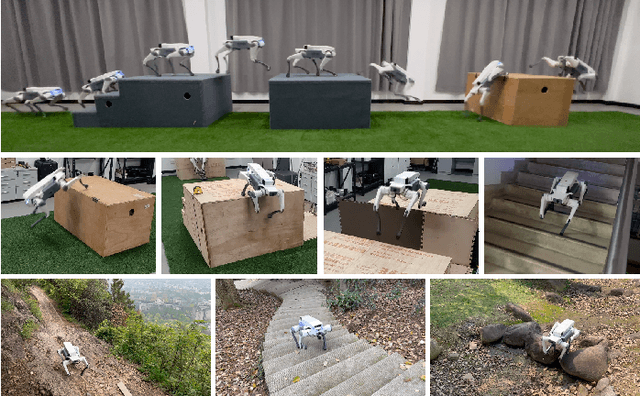
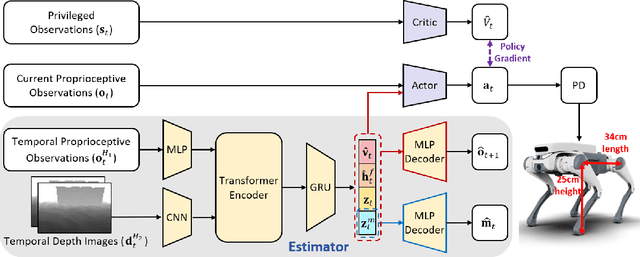

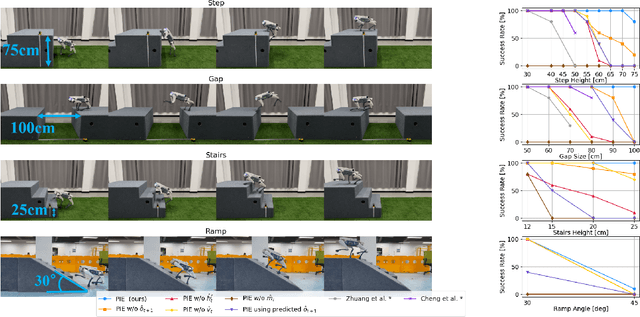
Abstract:Parkour presents a highly challenging task for legged robots, requiring them to traverse various terrains with agile and smooth locomotion. This necessitates comprehensive understanding of both the robot's own state and the surrounding terrain, despite the inherent unreliability of robot perception and actuation. Current state-of-the-art methods either rely on complex pre-trained high-level terrain reconstruction modules or limit the maximum potential of robot parkour to avoid failure due to inaccurate perception. In this paper, we propose a one-stage end-to-end learning-based parkour framework: Parkour with Implicit-Explicit learning framework for legged robots (PIE) that leverages dual-level implicit-explicit estimation. With this mechanism, even a low-cost quadruped robot equipped with an unreliable egocentric depth camera can achieve exceptional performance on challenging parkour terrains using a relatively simple training process and reward function. While the training process is conducted entirely in simulation, our real-world validation demonstrates successful zero-shot deployment of our framework, showcasing superior parkour performance on harsh terrains.
 Add to Chrome
Add to Chrome Add to Firefox
Add to Firefox Add to Edge
Add to Edge